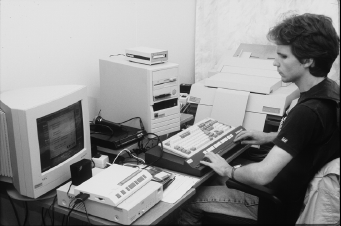

by Lena Birge and Margita Lundman
The Swedish Handicap Institute aims at improving the quality of life for people with disabilities by ensuring access to high quality and well functioning technical aids. The Institute's tasks include stimulation of research and development, testing of new technical devices and the provision of information and training. The Institute is run by the Government and the Federation of Swedish County Councils.
The Institute tries to influence the entire Swedish society. New technology in the service of people with disabilities is a special area for the Institute. It is important to be aware of both the problems and the opportunities arising with the new technology.
Approximately 10% of the population in Sweden, and many other countries in Europe, has a disability. In geographic Europe the number of people with disabilities were estimated in 1996 to be the following:
| Cannot use fingers | 1 million |
| Wheelchair users | 3 million |
| Dyslexia | 25 million |
| Hard of hearing | 80 million |
| Low vision | 11 million |
Many disabilities follow ageing. Today it is estimated that 100 million people are over retirement age in geographic Europe. Some of the Institute's research and development projects are shortly described below:
The Institute is presently building a Smart House. The aim includes to demonstrate the use of interfaces for environmental control. With computers activated in different ways, for example through speech recognition, people with severe functional impairments can control virtually all equipment in the home or get help and information. Braille output, magnification and speech synthesis have since long enabled visually impaired and blind people to use and benefit from the information technology. Today, the graphical interfaces have become a big problem since it is difficult to represent them in Braille or speech. The Cesar project, Comparative Evaluation of Screen Alternatives for Reading, evaluates how visually impaired and blind computer users can get access to the Windows graphical user interface.

The Cesar Project has evaluated how blind computer users
can get access to the Windows graphical interface through Braille output.
The new multimedia technique has led to a higher quality of life for several groups of disabled. Teleworking can be a positive way of working for many people with mobility impairment. Deaf and hard of hearing people can benefit from video telephony, where they can use sign language and lip-reading as well as get remote interpretation help. In Sweden several projects with remote sign language interpretation will result in an official interpretation service. The Swedish Government has commissioned the Swedish Handicap Institute to develop a programme on the access and use of information technology by disabled and elderly people. The programme will describe the state of the art and propose further research and development and other actions. The programme will be completed in May 1997.
Please contact:
Lena Birge or Margita Lundman - The Swedish Handicap Institute
Tel: +46 8 790 17 00
E-mail: margita.lundman@hi.se